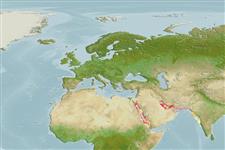>
Eupercaria/misc (Various families in series Eupercaria) >
Labridae (Wrasses) > Corinae
Etymology: Macropharyngodon: Greek, makros = great + Greek, pharyngx = pharynx + Greek,odous = teeth (Ref. 45335).
More on author: Randall.
Environment: milieu / climate zone / depth range / distribution range
Écologie
marin récifal; non migrateur; profondeur 4 - 16 m. Tropical
Western Indian Ocean: Red Sea.
Taille / Poids / Âge
Maturity: Lm ? range ? - ? cm
Max length : 9.5 cm SL mâle / non sexé; (Ref. 2694)
Description synthétique
Morphologie | Morphométrie
Épines dorsales (Total): 9; Rayons mous dorsaux (Total): 11; Épines anales 3; Rayons mous anaux: 11. This species is distinguished by the following characters: D IX,11; A III,11; pectoral rays 12 (including upper rudimentary ray); complete lateral line, angling downward below last 3 or 4 dorsal rays to straight peduncular portion, 27 pored scales (plus 1 on base of caudal fin); anterior lateral-line scales with 2 or 3 (rarely 4) pores; gill rakers 14-17; body depth 2.6-2.9 in SL; head length (HL) 2.95-3.05 in SL; snout short, 3.3-3.7 in HL; upper jaw with 2 pairs of canine teeth, 1st pair straight and strongly projecting anteriorly, 2nd pair about two-thirds as long, with tips recurved and outflaring; lower jaw with a medial pair of long, straight, forward-jutting, canine teeth, each with an adjacent more slender canine about two-thirds as long, with recurved tip; side of jaws with single row of close-set conical teeth, progressively shorter posteriorly; a very large, slender, forward-projecting, canine tooth posteriorly on upper jaw; lower pharyngeal plate with an enormous central molariform tooth, on each side anteriorly with a row of small conical teeth, continuing as a single row on the long anterior process; each of the pair of upper pharyngeal plates with 2 large, nearly square molars, preceded by a patch of small stout conical teeth; orbit diameter 4.25-4.95 in HL; origin of dorsal fin slightly anterior to a vertical at upper end of gill opening; first dorsal spine 4.25-5.25 in HL; remaining spines progressively longer, 9th 3.1-3.25 in HL; 5th or 6th dorsal soft ray longest, 1.9-2.2 in HL; 3rd anal spine longest, 2.45-3.55 in HL; 5th or 6th anal soft ray longest, 1.95-2.2 in HL; caudal fin slightly rounded, 1.2-1.3 in HL; pectoral fins 1.4-1.5 in HL; pelvic fins 1.35-1.8 in HL, usually reaching to or slightly posterior to origin of anal fin in mature males, usually not reaching anus in females (Ref. 93522).
Life cycle and mating behavior
Maturité | Reproduction | Frai | Œufs | Fécondité | Larves
Oviparous, distinct pairing during breeding (Ref. 205).
Randall, J.E., 2013. Seven new species of labrid fishes (Coris, Iniistius, Macropharyngodon, Novaculops, and Pteragogus) from the Western Indian Ocean. J. Ocean Sci. Found. 7:1-43. (Ref. 93522)
Statut dans la liste rouge de l'IUCN (Ref. 130435)
Menace pour l'homme
Harmless
Utilisations par l'homme
Plus d'informations
Taille/ÂgeCroissanceLongueur-poidsLongueur-longueurFréquences de longueursMorphométrieMorphologieLarvesDynamique des populations larvairesRecrutementAbondanceBRUVS
RéférencesAquacultureProfil d'aquacultureSouchesGénétiqueElectrophoresesHéritabilitéPathologiesTraitementNutrientsMass conversion
CollaborateursImagesStamps, Coins Misc.SonsCiguateraVitesseType de nageSurface branchialeOtolithesCerveauxVision
Outils
Articles particuliers
Télécharger en XML
Sources Internet
Estimates based on models
Preferred temperature (Ref.
123201): 24.6 - 29.3, mean 27.5 °C (based on 183 cells).
Phylogenetic diversity index (Ref.
82804): PD
50 = 0.5002 [Uniqueness, from 0.5 = low to 2.0 = high].
Bayesian length-weight: a=0.01995 (0.00906 - 0.04395), b=3.01 (2.83 - 3.19), in cm total length, based on all LWR estimates for this body shape (Ref.
93245).
Niveau trophique (Ref.
69278): 3.5 ±0.4 se; based on size and trophs of closest relatives
Résilience (Ref.
120179): Haut, temps minimum de doublement de population inférieur à 15 mois (Preliminary K or Fecundity.).
Fishing Vulnerability (Ref.
59153): Low vulnerability (10 of 100).
Nutrients (Ref.
124155): Calcium = 115 [56, 202] mg/100g; Iron = 0.782 [0.386, 1.575] mg/100g; Protein = 18.1 [15.2, 20.4] %; Omega3 = 0.125 [0.071, 0.214] g/100g; Selenium = 19.9 [10.4, 40.6] μg/100g; VitaminA = 125 [33, 637] μg/100g; Zinc = 1.66 [1.05, 2.79] mg/100g (wet weight);
